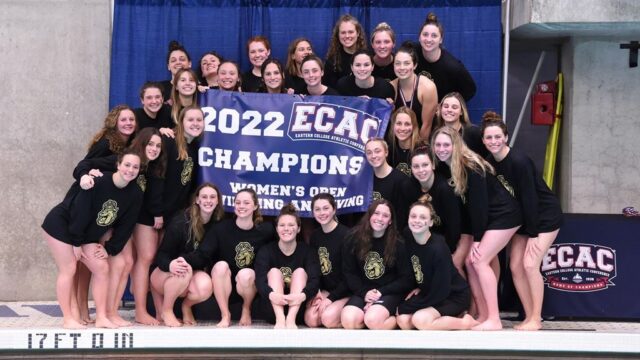By Braden Keith on SwimSwam

As the American swimming community unpacks the radical changes to the NCAA Championship format that was approved by the NCAA Swimming & Diving Sport Oversight Committee last week, there will be lots of questions about the nuance of the rules. Piece-by-piece, we’ll together learn the wrinkles of how the new system will work in fringe situations.
Two good questions that have come up so far are these:
- Does the Conference Champion have to clear the qualifying standard at the conference meet? and
- Does this apply to every NCAA Division I conference? And what defines a conference?
Under the new rules, conference champions who clear a certain time standard, based on the 72nd-ranked time in the country from past seasons, receive an automatic qualification to the NCAA Championships – even if they are slower than another swimmer in the same event.
2026 Women’s NCAA Division 1 Qualifying Times
Individual Events
Event Standard 50 Freestyle 22.28 100 Freestyle 48.60 200 Freestyle 1:45.53 500 Freestyle 4:43.70 1,650 Freestyle 16:25.29 100 Butterfly 52.52 200 Butterfly 1:57.11 100 Backstroke 52.65 200 Backstroke 1:54.80 100 Breaststroke 1:00.30 200 Breaststroke 2:11.27 200 Individual Medley 1:57.88 400 Individual Medley 4:13.20 2026 Men’s NCAA Division 1 Qualifying Times
Individual Events
Event Standard 50 Freestyle 19.43 100 Freestyle 42.55 200 Freestyle 1:33.93 500 Freestyle 4:18.07 1,650 Freestyle 15:06.60 100 Butterfly 46.11 200 Butterfly 1:43.79 100 Backstroke 46.29 200 Backstroke 1:42.14 100 Breaststroke 52.58 200 Breaststroke 1:54.95 200 Individual Medley 1:44.13 400 Individual Medley 3:46.19
Conference Championship-Winning Times
The simple answer to the first question is that the qualifying standard needs to be cleared during the conference title-winning swim.
If we accept the rule (which many in swimming still do not), then this is a great addition, because it gives a punctuated moment of exuberance that a conference can build hoopla around. Steamers, fireworks, music, a massive celebration, social media content…all of these things are possible and can be enhanced by the singular moment. Singular moments are the best of swimming, and a move toward more of them will be objectively good for the watchability of the sport (Last Chance meets, we’re looking at you).
That means the time can’t be swum at:
- Dual meets
- Last Chance meets
- Mid-season invites
- Relay leadoffs
- Splits on longer races
- Time trials
This brough up another question though. What about teams that compete in multiple conferences, like members of the ECAC?
What Defines a Conference?
In certain applications, the NCAA has allowed teams to recognize multiple conference championship meets. Most prominently, that has historically been the Eastern College Athletic Conference (ECAC), a historical amalgamation of teams mostly in the Northeastern United States.
As of fall 2023, there were 78 Division I members, 7 Division II members, and 79 Division III members, with most competing in only one or a few sports (the ECAC is rising to prominence in esports competitions).
For NCAA Division I teams, the league sponsors cross country, equestrian, golf, gymnastics, swimming & diving, tennis, and track & field.
In swimming & diving, the conference’s championship meet has become effectively a last chance meet or an alternate championship for swimmers who didn’t make their conference rosters (though it has occasionally been recently been a primary championship for teams orphaned by conference realignment).
Under the new system, the ECAC won’t count for NCAA Championship qualifications.
The Oversight Committee put in place a few restrictions on what they will count as a conference for the purposes of an automatic qualifier conference).
- A conference must have a minimum of 5 teams of a gender to be Automatic Qualifier eligible.
- If a school’s primary conference affiliation sponsors swimming & diving, that is their conference for AQs.
This rules out both the ECAC, and any attempts to form new conferences for the purposes of Automatic Qualifiers.
For example, take schools like Northwestern, Missouri, Pitt, Texas A&M, and Georgia Tech. Those schools recruit good swimmers, many of whom ultimately rank in the top 72 in the country (which is how the Automatic Qualifier times were set), but who don’t often win conference titles because they race against the likes of Indiana, Texas and Cal.
Those schools couldn’t pull together and form a new super-conference just to escalate the number of NCAA Championship qualifiers they get.
This would also eliminate Automatic Qualifiers from conferences that have fewer than 5 teams of a gender, like, the old AAC men’s championship meet that was a dual between SMU and Cincinnati.
The committee has approved these conferences based on “currently available information”:
- America East Conference;
- American Athletic Conference (women’s only);
- Atlantic Coast Conference;
- Atlantic Sun Conference;
- Atlantic 10 Conference;
- Big East Conference;
- Big Ten Conference;
- Big 12 Conference;
- Big West Conference;
- Coastal Athletic Association;
- Horizon League;
- The Ivy League;
- Metro Atlantic Athletic Conference;
- Mid-American Conference (women’s only);
- Missouri Valley Conference;
- Mountain Pacific Sports Federation;
- Mountain West Conference (women’s only);
- Northeast Conference (women’s only);
- Patriot League;
- Southeastern Conference; and
- The Summit League.
What other questions do you have about the nuance of the rules? Leave them in the comments and we’ll try to get the answers.
Read the full story on SwimSwam: What Defines a ‘Conference Champion’? Unpacking the Details of the New NCAA Qualifying System


